Timeline of human evolution: Difference between revisions
| Line 236: | Line 236: | ||
| align="RIGHT" nowrap | 30 Ma |
| align="RIGHT" nowrap | 30 Ma |
||
|[[Image:Aegyptopithecus NT.jpg|right|thumb|200px|''[[Aegyptopithecus]]'']] |
|[[Image:Aegyptopithecus NT.jpg|right|thumb|200px|''[[Aegyptopithecus]]'']] |
||
[[Haplorrhini]] splits into infraorders [[New World monkey|Platyrrhini]] and [[Catarrhini]]. Platyrrhines, New World monkeys, have prehensile tails and males are color blind. They may have migrated to South America on a raft of vegetation across the relatively narrow Atlantic ocean ( |
[[Haplorrhini]] splits into infraorders [[New World monkey|Platyrrhini]] and [[Catarrhini]]. Platyrrhines, New World monkeys, have prehensile tails and males are color blind. They may have migrated to South America on a raft of vegetation across the relatively narrow Atlantic ocean (approx. 700 km). Catarrhines mostly stayed in [[Africa]] as the two continents drifted apart. Possible early ancestors of catarrhines include ''[[Aegyptopithecus]]'' and ''[[Saadanius]]''. |
||
|- valign="TOP" |
|- valign="TOP" |
||
| align="RIGHT" nowrap | 25 Ma |
| align="RIGHT" nowrap | 25 Ma |
||
Revision as of 11:32, 11 January 2012
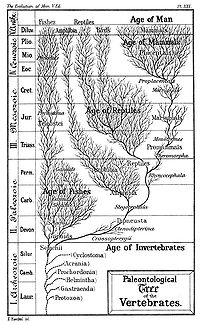
The evolutionary history of species has been described as a "tree", with many branches arising from a single trunk. While Haeckel's tree is somewhat outdated, it illustrates clearly the principles that more complex modern reconstructions can obscure.
The timeline of human evolution outlines the major events in the development of human species, and the evolution of humans' ancestors. It includes a brief explanation of some animals, species or genera, which are possible ancestors of Homo sapiens. It does not address the origin of life, which is addressed by abiogenesis, but presents a possible line of descendants that led to humans. This timeline is based on studies from paleontology, developmental biology, morphology and from anatomical and genetic data. The study of human evolution is a major component of anthropology.
Homo sapiens taxonomy
The cladistic line of descent (taxonomic rank) of Homo sapiens (modern humans) is as follows:
| Taxonomic rank | Name | Common name | |
| domain | Eukaryota | Cells with a nucleus | 2,100,000,000 years ago |
| kingdom | Animalia | Animals | 590,000,000 years ago |
| phylum | Chordata | Vertebrates and closely related invertebrates | 530,000,000 years ago |
| subphylum | Vertebrata | Vertebrates | 505,000,000 years ago |
| superclass | Tetrapoda | Tetrapods | 395,000,000 years ago |
| class | Mammalia | Mammals | 220,000,000 years ago |
| subclass | Theriiformes | Mammals that birth live young (i.e. non-egg-laying) | |
| infraclass | Eutheria | Placental mammals (i.e. non-marsupials) | 125,000,000 years ago |
| magnorder | Boreoeutheria | Supraprimates, bats, whales, most hoofed mammals, and most carnivorous mammals | |
| superorder | Euarchontoglires | Supraprimates (primates, rodents, rabbits, treeshrews, and colugos) | 100,000,000 years ago |
| grandorder | Euarchonta | Primates, colugos and treeshrews | |
| mirorder | Primatomorpha | Primates and colugos | 79,600,000 years ago |
| order | Primates | Primates | 75,000,000 years ago |
| suborder | Haplorrhini | "Dry-nosed" primates (apes, monkeys, and tarsiers) | 40,000,000 years ago |
| infraorder | Simiiformes | "Higher" primates (or Simians) (apes, old-world monkeys, and new-world monkeys) | |
| parvorder | Catarrhini | "Narrow nosed" primates (apes and old-world monkeys) | 30,000,000 years ago |
| superfamily | Hominoidea | Apes | 28,000,000 years ago |
| family | Hominidae | Great apes (Humans, chimpanzees, bonobos, gorillas, and orangutans) | 15,000,000 years ago |
| subfamily | Homininae | Humans, chimpanzees, bonobos, and gorillas | 8,000,000 years ago |
| tribe | Hominini | Humans, chimpanzees, and bonobos | 5,800,000 years ago |
| subtribe | Hominina | Bipedal apes (Australopithecus and descendants) | 3,000,000 years ago |
| genus | Homo | Humans, neanderthals, homo erectus, and their direct ancestors | 2,500,000 years ago |
| species | Homo sapiens | Humans | 500,000 years ago |
| sub-species | Homo sapiens sapiens | Modern humans | 200,000 years ago |
Timeline
First living beings
| Date | Event |
|---|---|
| 4000 Ma (million years ago) |
The earliest life appears. |
| 3900 Ma | Cells resembling prokaryotes appear. This marks the first appearance of photosynthesis and therefore the first occurrence of large quantities of oxygen on the earth. |
| 2500 Ma | First organisms to utilize oxygen. By 2400 Ma, in what is referred to as the Great Oxygenation Event, the pre-oxygen anaerobic forms of life were wiped out by the oxygen consumers. |
| 2100 Ma | More complex cells appear: the eukaryotes. |
| 1200 Ma | Sexual reproduction evolves, leading to faster evolution.[1] |
| 900 Ma |  The choanoflagellates may look similar to the ancestors of the entire animal kingdom, and in particular they may be the direct ancestors of Sponges.[2][3] Proterospongia (members of the Choanoflagellata) are the best living examples of what the ancestor of all animals may have looked like. They live in colonies, and show a primitive level of cellular specialization for different tasks. |
| 600 Ma | It is thought that the earliest multicellular animal was a sponge-like creature.
Sponges are among the simplest of animals, with partially differentiated tissues. Sponges (Porifera) are the phylogenetically oldest animal phylum extant today. |
| 580 Ma | Animal movement may have started with cnidarians. Almost all cnidarians possess nerves and muscles. Because they are the simplest animals to possess them, their direct ancestors were very likely the first animals to use nerves and muscles together. Cnidarians are also the first animals with an actual body of definite form and shape. They have radial symmetry. The first eyes evolved at this time. |
| 550 Ma |  |
| 540 Ma | Acorn worms are considered more highly specialised and advanced than other similarly shaped worm-like creatures. They have a circulatory system with a heart that also functions as a kidney. Acorn worms have a gill-like structure used for breathing, a structure similar to that of primitive fish. Acorn worms are thus sometimes said to be a link between vertebrates and invertebrates[citation needed]. |
Chordates
| Date | Event |
|---|---|
| 530 Ma |  The lancelet, still living today, retains some characteristics of the primitive chordates. It resembles Pikaia. |
| 505 Ma |  The first vertebrates appear: the ostracoderms, jawless fish related to present-day lampreys and hagfishes. Haikouichthys and Myllokunmingia are examples of these jawless fish, or Agnatha. (See also prehistoric fish). They were jawless and their internal skeletons were cartilaginous. They lacked the paired (pectoral and pelvic) fins of more advanced fish. They were precursors to the Osteichthyes (bony fish).[8] |
| 480 Ma |  The Placodermi were prehistoric fishes. Placoderms were the first of the jawed fishes, their jaws evolving from the first of their gill arches.[9] Their head and thorax were covered by articulated armoured plates and the rest of the body was scaled or naked. |
| 410 Ma | The first coelacanth appears;[10] this order of animals had been thought to have no extant members until living specimens were discovered in 1938. It is often referred to as a living fossil. |
Tetrapods
| Date | Event |
|---|---|
| 390 Ma |  Some fresh water lobe-finned fish (Sarcopterygii) develop legs and give rise to the Tetrapoda. The first tetrapods evolved in shallow and swampy freshwater habitats. Primitive tetrapods developed from a lobe-finned fish (an "osteolepid Sarcopterygian"), with a two-lobed brain in a flattened skull, a wide mouth and a short snout, whose upward-facing eyes show that it was a bottom-dweller, and which had already developed adaptations of fins with fleshy bases and bones. The "living fossil" coelacanth is a related lobe-finned fish without these shallow-water adaptations. These fishes used their fins as paddles in shallow-water habitats choked with plants and detritus. The universal tetrapod characteristics of front limbs that bend backward at the elbow and hind limbs that bend forward at the knee can plausibly be traced to early tetrapods living in shallow water.[11] Panderichthys is a 90–130 cm (35–50 in) long fish from the Late Devonian period (380 Mya). It has a large tetrapod-like head. Panderichthys exhibits features transitional between lobe-finned fishes and early tetrapods. Trackway impressions made by something that resembles Ichthyostega's limbs were formed 390 Ma in Polish marine tidal sediments. This suggests tetrapod evolution is older than the dated fossils of Panderichthys through to Ichthyostega. Lungfishes retain some characteristics of the early Tetrapoda. One example is the Queensland Lungfish. |
| 375 Ma |  Tiktaalik is a genus of sarcopterygian (lobe-finned) fishes from the late Devonian with many tetrapod-like features. It shows a clear link between Panderichthys and Acanthostega. |
| 365 Ma |   Acanthostega is an extinct amphibian, among the first animals to have recognizable limbs. It is a candidate for being one of the first vertebrates to be capable of coming onto land. It lacked wrists, and was generally poorly adapted for life on land. The limbs could not support the animal's weight. Acanthostega had both lungs and gills, also indicating it was a link between lobe-finned fish and terrestrial vertebrates. Ichthyostega is an early tetrapod. Being one of the first animals with legs, arms, and finger bones, Ichthyostega is seen as a hybrid between a fish and an amphibian. Ichthyostega had legs but its limbs probably weren't used for walking. They may have spent very brief periods out of water and would have used their legs to paw their way through the mud.[12] Amphibia were the first four-legged animals to develop lungs which may have evolved from Hynerpeton 360 Mya. Amphibians living today still retain many characteristics of the early tetrapods. |
| 300 Ma |  From amphibians came the first reptiles: Hylonomus is the earliest known reptile. It was 20 cm (8 in) long (including the tail) and probably would have looked rather similar to modern lizards. It had small sharp teeth and probably ate millipedes and early insects. It is a precursor of later Amniotes and mammal-like reptiles. Α-keratin first evolves here which is used in claws in modern lizards and birds, and hair in mammals.[13] Evolution of the amniotic egg gives rise to the Amniota, reptiles that can reproduce on land and lay eggs on dry land. They did not need to return to water for reproduction. This adaptation gave them the capability to colonize the uplands for the first time. Reptiles have advanced nervous systems, compared to amphibians. They have twelve pairs of cranial nerves. |
Mammals
| Date | Event |
|---|---|
| 256 Ma |  The earliest mammal-like reptiles are the pelycosaurs. The pelycosaurs were the first animals to have temporal fenestra. Pelycosaurs are not Therapsids but soon they gave rise to them. The Therapsida were the direct ancestor of mammals. The therapsids have temporal fenestrae larger and more mammal-like than pelycosaurs, their teeth show more serial differentiation; and later forms had evolved a secondary palate. A secondary palate enables the animal to eat and breathe at the same time and is a sign of a more active, perhaps warm-blooded, way of life.[14] |
| 220 Ma |  One sub-group of therapsids, the cynodonts evolved more mammal-like characteristics. The jaws of cynodonts resemble modern mammal jaws. It is very likely this group of animals contains a species which is the direct ancestor of all modern mammals.[15] |
| 220 Ma | 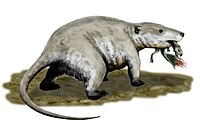 From Eucynodontia (cynodonts) came the first mammals. Most early mammals were small and shrew-like animals that fed on insects. Although there is no evidence in the fossil record, it is likely that these animals had a constant body temperature and milk glands for their young. The neocortex region of the brain first evolved in mammals and thus is unique to them. Monotremes are an egg laying group of mammals represented amongst modern animals by the platypus and spiny anteaters. Recent genome sequencing of the platypus indicates that its sex genes are closer to that of birds than to the other theria (live birthing) mammals. Comparing this to other mammals, it can be inferred that the first mammals to gain gender differentiation through the existence or lack of SRY gene (found in the y-Chromosome) evolved after this point. |
| 160 Ma |  Juramaia sinensis,[16] is the earliest known eutherian (placental) mammal fossil. Eomaia scansoria, is an early eutherian mammal dating to 125 Ma. It looks like a modern dormouse, climbing small shrubs in Liaoning, China. The remaining mammal group went on to represent the marsupial line that survives to this day in hundreds of animal species including the kangaroo. |
| 100 Ma | Common genetic ancestor of mice and humans (base of the clade Euarchontoglires). |
Primates
| Date | Event |
|---|---|
| 65–85 Ma |  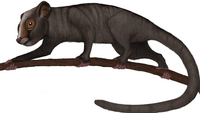 A group of small, nocturnal and arboreal, insect-eating mammals called the Euarchonta begins a speciation that will lead to the primate, treeshrew and flying lemur orders. The Primatomorpha is a subdivision of Euarchonta that includes the primates and the proto-primate Plesiadapiformes. One of the early proto-primates is Plesiadapis. Plesiadapis still had claws and the eyes located on each side of the head. Because of this they were faster on the ground than on the top of the trees, but they began to spend long times on lower branches of trees, feeding on fruits and leaves. The Plesiadapiformes very likely contain the species which is the ancestor of all primates.[17] One of the last Plesiadapiformes is Carpolestes simpsoni. It had grasping digits but no forward-facing eyes. |
| 40 Ma | Primates diverge into suborders Strepsirrhini (wet-nosed primates) and Haplorrhini (dry nosed primates). Strepsirrhini contain most of the prosimians; modern examples include the lemurs and lorises. The haplorrhines include the three living groups: prosimian tarsiers, simian monkeys, and apes. One of the earliest haplorrhines is Teilhardina asiatica, a mouse-sized, diurnal creature with small eyes. The Haplorrhini metabolism lost the ability to make its own Vitamin C. This means that it and all its descendants had to include fruit in its diet, where Vitamin C could be obtained externally. |
| 30 Ma | 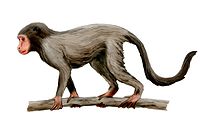 Haplorrhini splits into infraorders Platyrrhini and Catarrhini. Platyrrhines, New World monkeys, have prehensile tails and males are color blind. They may have migrated to South America on a raft of vegetation across the relatively narrow Atlantic ocean (approx. 700 km). Catarrhines mostly stayed in Africa as the two continents drifted apart. Possible early ancestors of catarrhines include Aegyptopithecus and Saadanius. |
| 25 Ma | 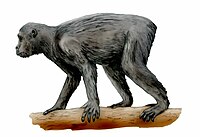 Catarrhini splits into 2 superfamilies, Old World monkeys (Cercopithecoidea) and apes (Hominoidae). Our trichromatic color vision had its genetic origins in this period. Proconsul was an early genus of catarrhine primates. They had a mixture of Old World monkey and ape characteristics. Proconsul's monkey-like features include thin tooth enamel, a light build with a narrow chest and short forelimbs, and an arboreal quadrupedal lifestyle. Its ape-like features are its lack of a tail, ape-like elbows, and a slightly larger brain relative to body size. Proconsul africanus is a possible ancestor of both great and lesser apes, and humans. |
Hominidae
| Date | Event |
|---|---|
| 15 Ma | Hominidae (great apes) speciate from the ancestors of the gibbon (lesser apes). |
| 13 Ma | Homininae ancestors speciate from the ancestors of the orangutan.[18]
Pierolapithecus catalaunicus is believed to be a common ancestor of humans and the great apes or at least a species that brings us closer to a common ancestor than any previous fossil discovery. Pierolapithecus had special adaptations for tree climbing, just as humans and other great apes do: a wide, flat ribcage, a stiff lower spine, flexible wrists, and shoulder blades that lie along its back. |
| 10 Ma | Hominini speciate from the ancestors of the gorillas. |
| 7 Ma | 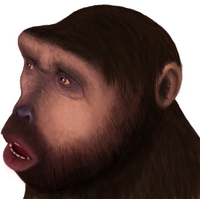 Hominina speciate from the ancestors of the chimpanzees. The latest common ancestor lived around the time of Sahelanthropus tchadensis, ca. 7 Ma [4]; S. tchadensis is sometimes claimed to be the last common ancestor of humans and chimpanzees, but this is disputed. The earliest known human ancestor post-dating the separation of the human and the chimpanzee lines is Orrorin tugenensis (Millennium Man, Kenya; ca. 6 Ma). Both chimpanzees and humans have a larynx that repositions during the first two years of life to a spot between the pharynx and the lungs, indicating that the common ancestors have this feature, a precursor of speech. |
| 4.4 Ma | Ardipithecus is a very early hominin genus (subfamily Homininae). Two species are described in the literature: A. ramidus, which lived about 4.4 million years ago[19] during the early Pliocene, and A. kadabba, dated to approximately 5.6 million years ago[20] (late Miocene). A. ramidus had a small brain, measuring between 300 and 350 cm3. This is about the same size as modern bonobo and female common chimpanzee brain, but much smaller than the brain of australopithecines like Lucy (~400 to 550 cm3) and slightly over a fifth the size of the modern Homo sapiens brain. Ardipithecus was aboreal, meaning it lived largely in the forest where it competed with other forest animals for food, including the contemporary ancestor for the chimpanzees. Ardipithecus was likely bipedal as evidenced by its bowl shaped pelvis, the angle of its foramen magnum and its thinner wrist bones, though its feet were still adapted for grasping rather than walking for long distances. |
| 3.6 Ma | |
| 3.5 Ma | Kenyanthropus platyops, a possible ancestor of Homo, emerges from the Australopithecus genus. |
| 3 Ma | The bipedal australopithecines (a genus of the Hominina subtribe) evolve in the savannas of Africa being hunted by Dinofelis. Loss of body hair takes place in the period 3-2 Ma, in parallel with the development of full bipedalism. |
Homo
| Date | Event |
|---|---|
| 2.5 Ma | Appearance of Homo. Homo habilis is thought to be the ancestor of the lankier and more sophisticated Homo ergaster. Lived side by side with Homo erectus until at least 1.44 Ma, making it highly unlikely that Homo erectus directly evolved out of Homo habilis. First stone tools, beginning of the Lower Paleolithic. |
| 1.8 Ma | Homo erectus evolves in Africa. Homo erectus would bear a striking resemblance to modern humans, but had a brain about 74 percent of the size of modern man. Its forehead is less sloping and the teeth are smaller. Other hominid designations such as Homo georgicus, Homo ergaster, Homo pekinensis, Homo heidelbergensis are often put under the umbrella species name of Homo erectus.[21] Starting with Homo georgicus found in what is now the Republic of Georgia dated at 1.8 Ma, the pelvis and backbone grew more human-like and gave H. georgicus the ability to cover very long distances in order to follow herds of other animals. This is the oldest fossil of a hominid found (so far) outside of Africa. Control of fire by early humans is achieved 1.5 Ma by Homo ergaster. Homo ergaster reaches a height of around 1.9 metres (6.2 ft). Evolution of dark skin, which is linked to the loss of body hair in human ancestors, is complete by 1.2 Ma. Homo pekinensis first appears in Asia around 700 Ka but according to the theory of a recent African origin of modern humans, they could not be human ancestors, but rather, were just a cousin offshoot species from Homo ergaster. Homo heidelbergensis was a very large hominid that had a more advanced complement of cutting tools and may have hunted big game such as horses. |
| 1.2 Ma | Homo antecessor may be a common ancestor of humans and Neanderthals.[22][23] At present estimate, humans have approximately 20,000–25,000 genes and share 99% of their DNA with the now extinct Neanderthal [24] and 95-99% of their DNA with their closest living evolutionary relative, the chimpanzees[25][26] The human variant of the FOXP2 gene (linked to the control of speech) has been found to be identical in Neanderthals.[27] It can therefore be deduced that Homo antecessor would also have had the human FOXP2 gene. |
| 600 ka | Three 1.5 m (5 ft) tall Homo heidelbergensis left footprints in powdery volcanic ash solidified in Italy. Homo heidelbergensis may be a common ancestor of humans and Neanderthals.[28] It is morphologically very similar to Homo erectus but Homo heidelbergensis had a larger brain-case, about 93% the size of that of Homo sapiens. The holotype of the species was tall, 1.8 m (6 ft) and more muscular than modern humans. Beginning of the Middle Paleolithic. |
| 200 ka |  Omo1, Omo2 (Ethiopia, Omo river) are the earliest fossil evidence for anatomically modern Homo sapiens.[29] |
| 160 ka | Homo sapiens (Homo sapiens idaltu) in Ethiopia, Awash River, Herto village, practice mortuary rituals and butcher hippos. Potential earliest evidence of anatomical and behavioral modernity consistent with the continuity hypothesis including use of red ochre and fishing.[30] |
| 150 ka | Mitochondrial Eve is a woman that lived in East Africa. She is the most recent female ancestor common to all mitochondrial lineages in humans alive today. Note that there is no evidence of any characteristic or genetic drift that significantly differentiated her from the contemporary social group she lived with at the time. Her ancestors were homo sapiens and her mother had the same mtDNA. |
| 70 ka | Appearance of mitochondrial haplogroup L2. Behavioral modernity according to the "great leap forward" theory.[31] |
| 142 to 60 ka |
Y-chromosomal Adam lives in Africa. He is the most recent common ancestor from whom all male human Y chromosomes are descended. |
| 60 ka | Appearance of mitochondrial haplogroups M and N, which participate in the migration out of Africa. Homo sapiens that leave Africa in this wave start interbreeding with the Neanderthals they encounter.[32][33] |
| 50 ka | Migration to South Asia. M168 mutation (carried by all non-African males). Beginning of the Upper Paleolithic. mt-haplogroups U, K. |
| 40 ka | Migration to Australia[34] and Europe (Cro-Magnon). |
| 25 ka | The independent Neanderthal lineage dies out. Y-Haplogroup R2; mt-haplogroups J, X. |
| 12 ka | Beginning of the Mesolithic / Holocene. Y-Haplogroup R1a; mt-haplogroups V, T. Evolution of light skin in Europeans (SLC24A5). Homo floresiensis dies out, leaving Homo sapiens as the only living species of the genus Homo. |
See also
- Timeline of prehistory
- Chimpanzee-human last common ancestor
- Graphical timeline of our universe
- History of Earth
- Natural history
- History of the world
- Evolutionary history of life
- Homininae
- Human evolution
- Human taxonomy
- Homo
- Most recent common ancestor
- List of human evolution fossils
- Prehistoric amphibian
- Prehistoric fish
- Prehistoric reptile
- The Ancestor's Tale by Richard Dawkins with a timeline comprising 40 rendezvous points
- Timeline of evolution - an explanation of the evolution of a wide variety of animals living today
- Y-DNA haplogroups by ethnic groups
References
- ^ "'Experiments with sex have been very hard to conduct,' Goddard said. 'In an experiment, one needs to hold all else constant, apart from the aspect of interest. This means that no higher organisms can be used, since they have to have sex to reproduce and therefore provide no asexual control.'
Goddard and colleagues instead turned to a single-celled organism, yeast, to test the idea that sex allows populations to adapt to new conditions more rapidly than asexual populations." Sex Speeds Up Evolution, Study Finds (URL accessed on January 9, 2005) - ^ Dawkins, R. (2005), The Ancestor's Tale: A Pilgrimage to the Dawn of Evolution, Houghton Mifflin Harcourt, ISBN 9780618619160
- ^ "Proterospongia is a rare freshwater protist, a colonial member of the Choanoflagellata." "Proterospongia itself is not the ancestor of sponges. However, it serves as a useful model for what the ancestor of sponges and other metazoans may have been like." http://www.ucmp.berkeley.edu/protista/proterospongia.html Berkeley University
- ^ "Obviously vertebrates must have had ancestors living in the Cambrian, but they were assumed to be invertebrate forerunners of the true vertebrates — protochordates. Pikaia has been heavily promoted as the oldest fossil protochordate." Richard Dawkins 2004 The Ancestor's Tale Page 289, ISBN 0-618-00583-8
- ^ Attention: This template ({{cite doi}}) is deprecated. To cite the publication identified by doi:10.1038/46965, please use {{cite journal}} (if it was published in a bona fide academic journal, otherwise {{cite report}} with
|doi=10.1038/46965instead. - ^ Attention: This template ({{cite doi}}) is deprecated. To cite the publication identified by doi:10.1038/990080, please use {{cite journal}} (if it was published in a bona fide academic journal, otherwise {{cite report}} with
|doi=10.1038/990080instead. - ^ Attention: This template ({{cite doi}}) is deprecated. To cite the publication identified by doi:10.1038/nature01264, please use {{cite journal}} (if it was published in a bona fide academic journal, otherwise {{cite report}} with
|doi=10.1038/nature01264instead. - ^ These first vertebrates lacked jaws, like the living hagfish and lampreys. Jawed vertebrates appeared 100 million years later, in the Silurian. http://www.ucmp.berkeley.edu/vertebrates/vertintro.html Berkeley University
- ^ "Bones of first gill arch became upper and lower jaws." (Image)
- ^ A fossil coelacanth jaw found in a stratum datable 410 mya that was collected near Buchan in Victoria, Australia's East Gippsland, currently holds the record for oldest coelacanth; it was given the name Eoactinistia foreyi when it was published in September 2006. [1]
- ^ "Lungfish are believed to be the closest living relatives of the tetrapods, and share a number of important characteristics with them. Among these characters are tooth enamel, separation of pulmonary blood flow from body blood flow, arrangement of the skull bones, and the presence of four similarly sized limbs with the same position and structure as the four tetrapod legs." http://www.ucmp.berkeley.edu/vertebrates/sarco/dipnoi.html Berkeley University
- ^ "the ancestor that amphibians share with reptiles and ourselves? " " These possibly transitional fossils have been much studied, among them Acanthostega, which seems to have been wholly aquatic, and Ichthyostega" Richard Dawkins 2004 The Ancestor's Tale page 250, ISBN 0-618-00583-8
- ^ Eckhart L, Valle LD, Jaeger K; et al. (2008). "Identification of reptilian genes encoding hair keratin-like proteins suggests a new scenario for the evolutionary origin of hair". Proceedings of the National Academy of Sciences of the United States of America. 105 (47): 18419–23. doi:10.1073/pnas.0805154105. PMC 2587626. PMID 19001262.
{{cite journal}}: Explicit use of et al. in:|author=(help); Unknown parameter|month=ignored (help)CS1 maint: multiple names: authors list (link) - ^ "In many respects, the pelycosaurs are intermediate between the reptiles and mammals" http://www.ucmp.berkeley.edu/synapsids/pelycosaurs.html Berkeley University
- ^ "Thrinaxodon, like any fossil, should be thought of as a cousin of our ancestor, not the ancestor itself. It was a member of a group of mammal-like reptiles called the cynodonts. The cynodonts were so mammal-like, it is tempting to call them mammals. But who cares what we call them? They are almost perfect intermediates." Richard Dawkins 2004 The Ancestor's Tale page 211, ISBN 0-618-00583-8
- ^ A Jurassic eutherian mammal and divergence of marsupials and placentals http://dx.doi.org/10.1038/nature10291
- ^ "Fossils that might help us reconstruct what Concestor 8 was like include the large group called plesiadapi-forms. They lived about the right time, and they have many of the qualities you would expect of the grand ancestor of all the primates" Richard Dawkins 2004 The Ancestor's Tale page 136, ISBN 0-618-00583-8
- ^ Raauma, Ryan, Sternera, K., (2005) "Catarrhine primate divergence dates estimated from complete mitochondrial genomes", Journal of Human Evolution 48: 237-257 [2]
- ^ Perlman, David (July 12, 2001). "Fossils From Ethiopia May Be Earliest Human Ancestor". National Geographic News. Retrieved July 2009.
Another co-author is Tim D. White, a paleoanthropologist at UC-Berkeley who in 1994 discovered a pre-human fossil, named Ardipithecus ramidus, that was then the oldest known, at 4.4 million years.
{{cite web}}: Check date values in:|accessdate=(help) - ^ White, Tim D. (2009). "Ardipithecus ramidus and the Paleobiology of Early Hominids". Science. 326 (5949): 75–86. doi:10.1126/science.1175802. PMID 19810190.
{{cite journal}}: Cite has empty unknown parameter:|month=(help); Unknown parameter|coauthors=ignored (|author=suggested) (help) - ^ NOVA: Becoming Human Part 2 http://video.pbs.org/video/1319997127/
- ^ J. M. Bermúdez de Castro, et al. A Hominid from the Lower Pleistocene of Atapuerca, Spain: Possible Ancestor to Neandertals and Modern Humans. Science 1997 May 30; 276: 1392-1395.
- ^ Green, R. E., Krause, J, Ptak, S. E., Briggs, A. W., Ronan, M. T., Simons, J. F., et al. (2006) Analysis of one million base pairs of Neanderthal DNA. Nature, 16, 330–336. http://www.nature.com/nature/journal/v444/n7117/abs/nature05336.html
- ^ "Rubin also said analysis so far suggests human and Neanderthal DNA are some 99.5 percent to nearly 99.9 percent identical." Neanderthal bone gives DNA clues (URL accessed on November 16, 2006)
- ^ "The conclusion is the old saw that we share 98.5% of our DNA sequence with chimpanzee is probably in error. For this sample, a better estimate would be that 95% of the base pairs are exactly shared between chimpanzee and human DNA." Britten, R.J. (2002). "Divergence between samples of chimpanzee and human DNA sequences is 5%, counting indels". PNAS. 99 (21): 13633–5. doi:10.1073/pnas.172510699. PMC 129726. PMID 12368483.
- ^ "...of the three billion letters that make up the human genome, only 15 million--less than 1 percent--have changed in the six million years or so since the human and chimp lineages diverged." Pollard, K.S. (2009), "What makes us human?", Scientific American, 300–5: 44–49.
- ^ Krause J, Lalueza-Fox C, Orlando L, Enard W, Green RE, Burbano HA, Hublin JJ, Hänni C, Fortea J, de la Rasilla M, Bertranpetit J, Rosas A, Pääbo S (2007). "The derived FOXP2 variant of modern humans was shared with Neandertals". Curr. Biol. 17 (21): 1908–12. doi:10.1016/j.cub.2007.10.008. PMID 17949978.
{{cite journal}}: Unknown parameter|laydate=ignored (help); Unknown parameter|laysource=ignored (help); Unknown parameter|laysummary=ignored (help); Unknown parameter|month=ignored (help)CS1 maint: multiple names: authors list (link) - ^ Mounier,Aurélien; François Marchal and Silvana Condemi "Is Homo heidelbergensis a distinct species? New insight on the Mauer mandible" Journal of Human Evolution Volume 56, Issue 3, March 2009, Pages 219-246 [3]
- ^ Hopkin, Michael (2005-02-16). "Ethiopia is top choice for cradle of Homo sapiens". Nature News. doi:10.1038/news050214-10.
{{cite news}}: Cite has empty unknown parameter:|coauthors=(help) - ^ "Schwarz, J". Uwnews.org. 2007-10-17. Retrieved 2009-09-10.
- ^ Diamond, Jared (1992). The Third Chimpanzee. Harper Perennial. pp. 47–57. ISBN 978-0-060-98403-8.
- ^ Richard E. Green; et al. (2010). "A Draft Sequence of the Neandertal Genome". Science. 328 (5979): 710–722. doi:10.1126/science.1188021. PMID 20448178.
{{cite journal}}: Explicit use of et al. in:|author=(help) - ^ Rincon, Paul (2010-05-06). "Neanderthal genes 'survive in us'". BBC News. BBC. Retrieved 2010-05-07.
{{cite news}}: External link in|work= - ^ Bowler JM, Johnston H, Olley JM, Prescott JR, Roberts RG, Shawcross W, Spooner NA. (2003). "New ages for human occupation and climatic change at Lake Mungo, Australia". Nature. 421 (6925): 837–40. doi:10.1038/nature01383. PMID 1259451.
{{cite journal}}: CS1 maint: multiple names: authors list (link)
External links
- Palaeos
- Hominid Timeline
- Berkeley Evolution
- Tree of Life Web Project - explore complete phylogenetic tree interactively
- History of Animal Evolution
- Human Evolution Timeline Interactive by The Smithsonian Institution's Human Origins Program

